You’ve have heard of reflections in photography, but have you have tried refraction? When used well, refraction creates compelling images that will leave your audience both wowed and curious. I’ve been approached many times by strangers who are curious about how I photograph with a glass ball. Once you’ve mastered this type of photograph you’ll likely get the same audience. Here are some tips to help you do crystal ball refraction photography.
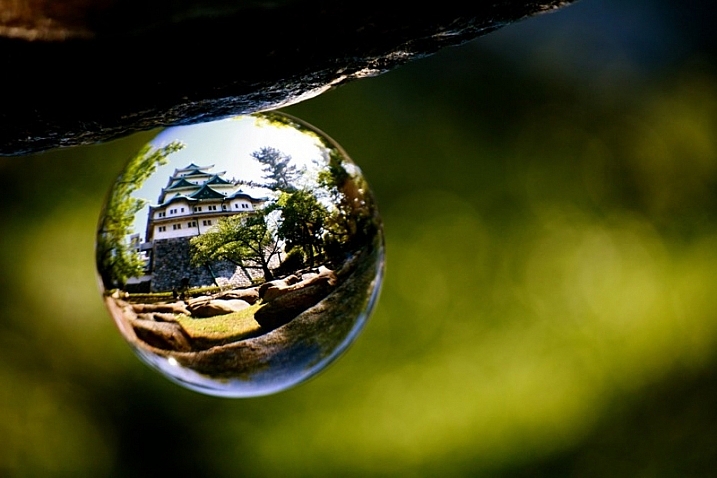
The subject shows prominently in the ball, and around the ball is bokeh.
So what is refraction?
Refraction happens when light passes through an object of denser mass, such as water or glass. When this occurs, light is bent, and there is a distortion. When refraction occurs with a transparent spherical object something magical happens. An inverted image of the scene behind the ball is seen. The lens elements in your camera actually work this way as well. You can use a glass ball as an extra lens element, one you can move around your scene.
How to do refraction photography
Now you know what refraction is, it’s time to learn how to apply it to your photography. If you follow the guide below you won’t go far wrong with this type of photography.
#1 – Dealing with the upside down image
There are instances where it works to have an upside down image in the background or inside the ball. If you want to avoid this, the best way to deal with an upside down background is to blur it out using bokeh. An alternative to blurring out the background is to use reflection since the reflected image will be the right way up inside the ball.
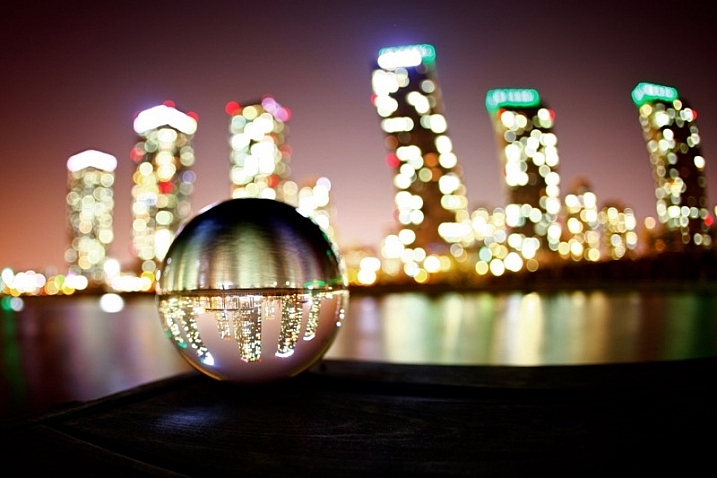
The image inside the ball will be upside down.
#2 – Get above your subject
You should get the ball off the ground so it’s level with the subject you’re photographing. A centered subject in the ball will have less distortion and more impact in the frame. There are always exceptions, of course, as leaf beds or puddles work well when the ball is placed right in them.
#3 – Fill the glass ball with your subject
You have to get close to your subject, or it (they) will appear very small inside the ball. The best advice I can give here is to see if your scene would fill a wide angle lens. If so you’re gold.
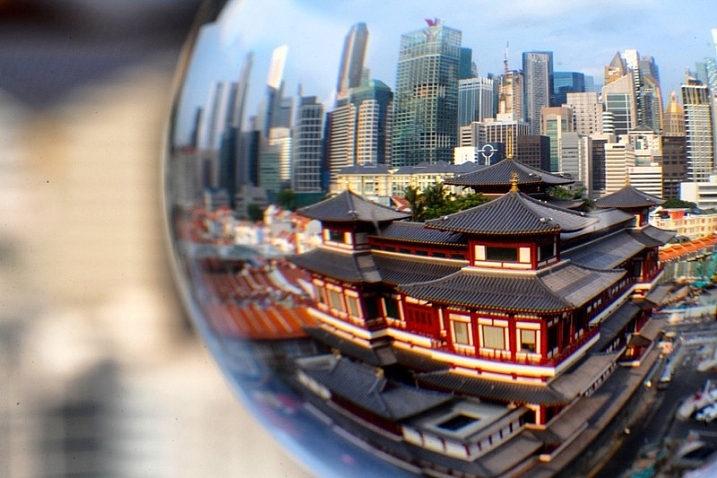
In this photo, the cityscape is captured inside the ball, and a closer framing was employed.
#4 – Choose the correct lens
The best option here is to use a macro lens or a telephoto lens with macro capability. The macro lens will allow you to get close to the ball, making it easier to create bokeh around the ball. Using a wider angle lens can also work if your scene allows it.
#5 – Choose the correct aperture
You need to get the correct aperture for your scene. An aperture that’s too small won’t blur out the background. One that’s too large will make it hard to get a sharp image inside the ball. I would choose an aperture of around f/4, it depends on the scene you are photographing, though.

One of the best ways of dealing with the upside down image is to use reflection in the photo.
#6 – Find a safe place to position the ball
This is very important, especially if you are photographing from a high vantage point. The ball needs to sit on a flat surface, finding a crevice to sit the ball on is better. Once you have placed the ball ensure it isn’t going to fall and keep your hands near it during this time.
If there is no place to rest the ball you can ask a friend if they’ll hold the ball for you. You need to be especially careful on a windy day, a strong gust of wind can move the ball if it’s not in a secure position.

In this photo of the Taj Mahal, there is a reflection in the background, and this reflected image is in fact upside down.
#7 – Lighting the subject in front of the ball
You should have a well-lit subject in any kind of photo, but it’s even more important with refraction photographs. A strongly lit subject will shine through the ball with less reflection appearing on the ball. Look to photograph when the sun is behind you or during blue hour shooting towards lit buildings.
Refraction photography versus a standard landscape
A lot of locations that suit refraction photography with a glass ball will also be good for regular landscapes. The question is why photograph a refraction photo when you could take a wide-angle shot of the same scene? Let’s take a look at some of the pros and cons of crystal ball refraction photography.
Pros of refraction
- A glass ball is cheaper than a lens and allows you to create a fish-eye like effect.
- You can move the ball to different positions in your scene.
- Using a large aperture in conjunction with the ball to create bokeh, is great for minimalism.
- Scenes created with a crystal ball often have a more artistic feel.
- The ball creates a natural frame for your photo.
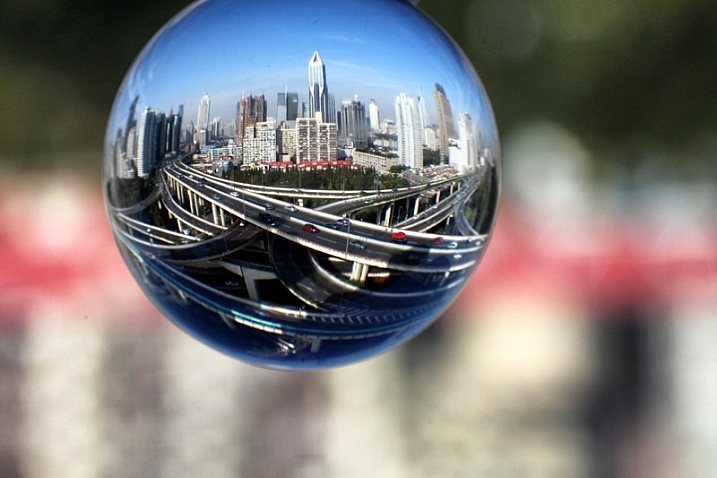
Scenes that are well suited for a wide-angle photo also often work well inside a crystal ball.
Cons of refraction
- The larger glass balls are heavy to carry, in an already heavy camera bag.
- You need a macro lens, something a landscape photographer may not normally carry.
- Distortion on the edge of the ball.
- It’s difficult to get a sharp image inside the ball.
- The image in the ball is upside down.
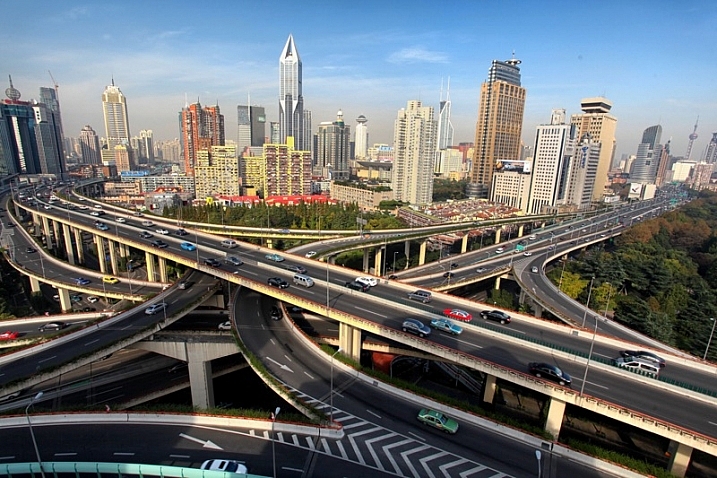
This is a wide angle photo of a famous road junction in Shanghai.
The choice of taking a glass ball is yours to make, I highly recommend experimenting with it, though. The pros really outweigh the cons, and following the tips in this article will help. You may also find weight an issue, so I recommend scouting a location before shooting with the ball. Then return for a second visit with just the equipment you need to take the photo, this will reduce the weight somewhat.
Experiment with the ball
The first thing you’ll need of course is a crystal ball, you can buy them easily through amazon for 27$. While you wait you can try filling a wine glass with water, you’ll get the refraction effect this way too.
Now you’re ready to get started, so head to a local landmark and start experimenting. The list of subjects is really endless; you can start with a lone tree, a church, or a cityscape scene. If you have any photos that show refraction please add them to the comments below, it would be great to see them.
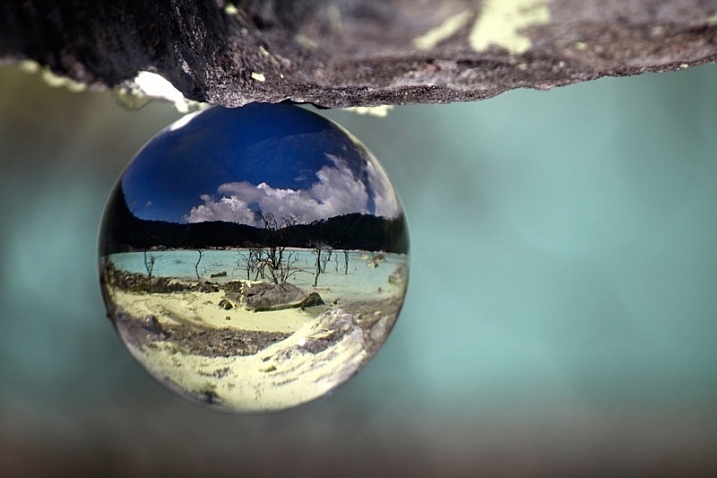
Natural landscapes look great inside the ball. This is a volcanic lake found in Indonesia.
The post 7 Tips for Doing Crystal Ball Refraction Photography by Simon Bond appeared first on Digital Photography School.
from Digital Photography School http://digital-photography-school.com/7-steps-refraction-photography/
No comments:
Post a Comment